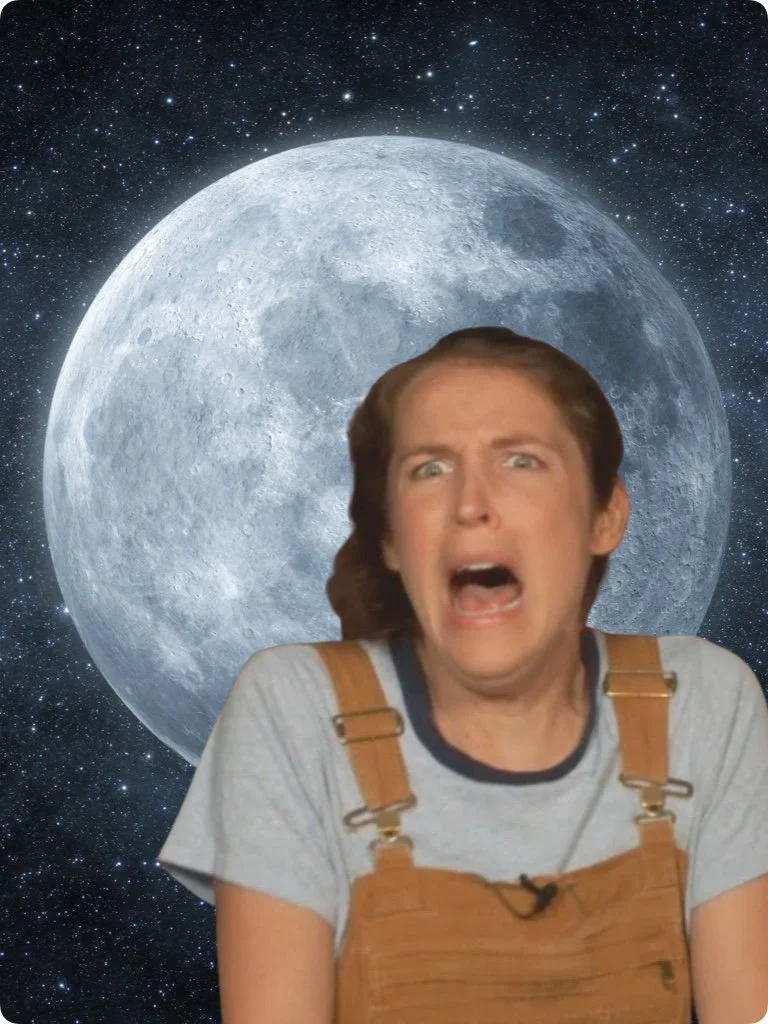Science Lessons for Kids > Astronomy & Planets > The Moon
13 Moon Facts & Trivia Questions for Kids
We see it every night, but how much do we really know about it? Well…a ton! Whether you’re an aspiring astronaut or ambitious astronomer, you’ve come to the right place for all the best K-5 Moon science around!
To get started, watch our video to the right for an explanation to the question “Where did the Moon come from?” or scroll down for more facts about the Moon!
Amazing Moon Facts for Kids
Check out these awesome lunar science nuggets - no telescope needed!
A Lunar Day is Longer Than a Lunar Year
The Moon takes 29.5 days to fully rotate, meaning that by the time a day passes on the Moon, it will have fully gone around the Earth, which only takes 27 days.
The Moon is 30 Earths Away from Earth
The Moon is farther away than most people think - you could fit 30 Earths in between the Earth and the Moon. Put another way, you could fit every single planet in the Solar System between the Earth and the Moon! And put a third way, if the Moon were a yo-yo, and your hand were the Earth, the string would be 6 feet long. The Moon is usually pictured as closer to the Earth than it really is because to picture it accurately requires making both the Moon and the Earth very small.
The Moon Has Moonquakes
That’s right! The Moon has moonquakes, just like the Earth has earthquakes. The strongest of them registered a 5.5 on the Richter scale - strong enough to move heavy furniture. And they continued for over 10 minutes! Astronomers still aren’t sure what causes these quakes - maybe astronauts on a Moon Base could study them further.
Moon Trivia Questions for Kids
Test your lunar literacy with these out-of-this-world trivia!
-
Yes! Well, with a lot of help. NASA has plans to establish a lunar base within the next 20 years that would allow astronauts to live on the Moon for up to 2 months.
-
Scientists believe the Moon used to be part of the Earth! According to the leading theory, when the Earth was first forming, another small early planet the size of Mars smashed into it, combining with it and blasting debris into orbit. That debris collected together over time due to gravity and eventually formed the Moon!
-
Yes! Astronomers have discovered ice on the North and South poles of the Moon, inside cold, permanently shadowed craters.
-
No life has yet been discovered on the Moon, and astronauts have checked! Scientists analyzed Moon rocks from the Apollo mission for lunar lifeforms, but didn’t find anything.
-
The Moon’s diameter is about ¼ Earth’s diameter. That means that if the Earth were the size of a bowling ball, the Moon would be about the size of a golf ball.
-
Sometimes it's a full Moon, sometimes it’s a half Moon, and sometimes it’s not there at all! What gives? Well, the Moon isn’t actually changing shape (we promise), but it is moving around the Earth. One side of the Moon is always facing the Sun, and one is facing away. When you look up at the sky, you can only see the side that’s lit up. So the amount of the lit-up side facing us changes as the Moon moves around the Earth. For example, when there’s a full Moon, the Moon is on the opposite side of the Earth from the Sun - so the entire lit-up side is facing us.
-
The movement of the Moon across the sky is mainly due to the rotation of the Earth. The Moon is also moving, but the Moon takes 27 days to get all the way around the Earth. Meanwhile, it takes the Earth just 12 hours to rotate halfway around. So the Moon’s movement across the sky is just like the Sun’s movement across the sky - mainly due to the rotation of the Earth.
-
Scientists estimate that the Moon is about 4.425 billion years old - only about 100 million years younger than the Earth.
-
There isn’t any weather on the Moon, because the Moon doesn’t have an atmosphere. In other words, there’s no air, so there's no wind to blow around. Because there’s no air, if you dropped a hammer and a feather at the same time on the Moon, they would fall at the same exact speed! Don’t believe it? An astronaut on the Apollo 15 mission tried it in 1971, so you can watch the video to see for yourself!
-
Yes! Scientists have successfully grown plants in samples of lunar dirt (called regolith) brought back from the Apollo missions. The plants grew slowly, but the fact that it’s possible at all is promising for establishing a lasting human presence on the Moon.
Kid-Friendly Ways to Learn More About The Moon
Play Tappity’s Video Lessons About The Moon
Tappity has a whole galaxy’s worth of interactive video lessons about the Moon! Check it out below!
Join Live, Online STEM Classes with Other Kids
Access the ultimate STEM course library. Choose from 1st-3rd grade science, math curriculum, interest-based topics, and creative skills like programming, video editing, and story writing.
Explore More Science Topics for Kids
From Volcanoes to Velociraptors, we’ve got it all - right here at Tappity.


































